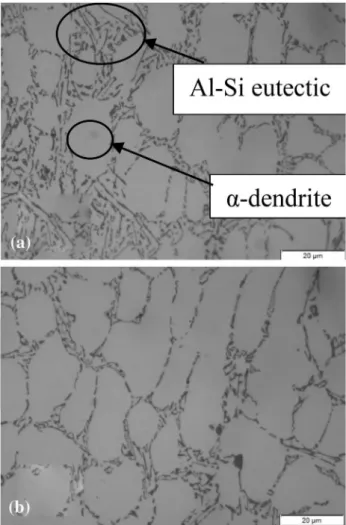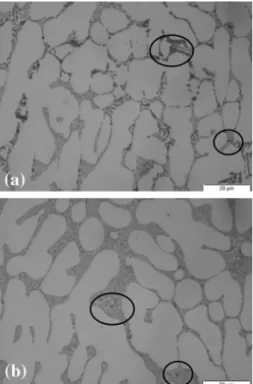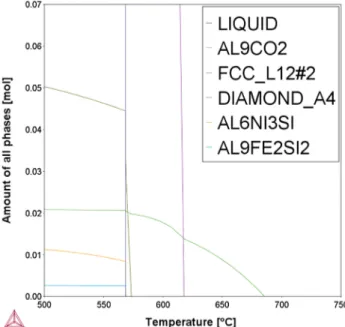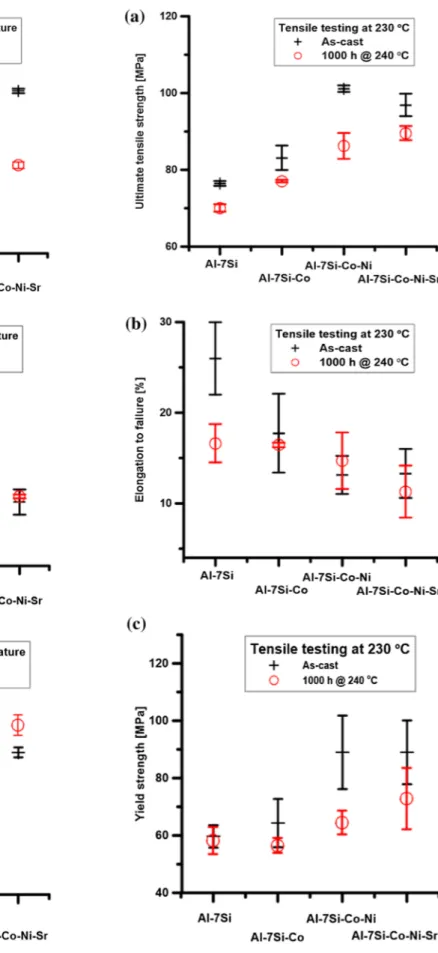http://www.diva-portal.org
This is the published version of a paper published in International Journal of metalcasting.
Citation for the original published paper (version of record):
Bogdanoff, T., Dahle, A K., Seifeddine, S. (2018)
Effect of Co and Ni Addition on the Microstructure and Mechanical Properties at Room
and Elevated Temperature of an Al–7%Si Alloy
International Journal of metalcasting, 12(3): 434-440
https://doi.org/10.1007/s40962-017-0178-z
Access to the published version may require subscription.
N.B. When citing this work, cite the original published paper.
Permanent link to this version:
EFFECT OF Co AND Ni ADDITION ON THE MICROSTRUCTURE AND MECHANICAL
PROPERTIES AT ROOM AND ELEVATED TEMPERATURE OF AN Al–7%Si ALLOY
Toni Bogdanoff , Arne K. Dahle , and Salem Seifeddine
Department of Materials and Manufacturing, School of Engineering, Jo¨nko¨ping University, Jo¨nko¨ping, Sweden
CopyrightÓ 2017 The Author(s). This article is an open access publication DOI 10.1007/s40962-017-0178-z
Abstract
Increasing environmental demands are forcing the auto-motive industry to reduce vehicle emissions by producing more light-weight and fuel efficient vehicles. Al–Si alloys are commonly used in automotive applications because of excellent castability, high thermal conductivity, good wear properties and high strength-to-weight ratio. However, most of the aluminium alloys on the market exhibit sig-nificantly reduced strength at temperatures above 200°C. This paper presents results of a study of the effects of Co and Ni in a hypoeutectic Al–Si alloy on microstructure and
mechanical properties at room and elevated temperature. Tensile test specimens with microstructures comparable to those obtained in high-pressure die casting, i.e. SDAS* 10lm, were produced by directional solidifica-tion in a Bridgman furnace. The results show an improvement in tensile properties up to 230°C.
Keywords: Al–Si alloy, mechanical properties, cobalt, nickel, elevated temperature
Introduction
Demands for reduced greenhouse gas emissions and for producing more fuel efficient vehicles have increased the use of light-weight materials in the automotive and aero-space industries.1 Weight reduction in the automotive industry is also important because of the increased weight of safety systems, luxury and comfort items that are required by the customers.2 Al–Si alloys are the most widely used aluminium alloys in the foundry industry because of their good fluidity, excellent castability, high strength-to-weight ratio, good corrosion resistance and good wear properties.3 However, the use of cast Al–Si alloys at temperatures exceeding 200°C is challenging because of the significant reduction in the mechanical properties at elevated temperature.2,4Therefore, research-ers have focused significant efforts into improving the mechanical properties of Al–Si alloys at elevated temper-atures through tailoring microstructure and alloy compo-sition, and addition of transition elements has been shown to promote thermally stable phases.2,4–7Both Co and Ni have high melting points and are well known as superalloys for high-temperature applications.8,9Limited studies have been carried out on the combined effects of Co and Ni in Al–Si alloys. This paper reports the results of a study into
the effects of Co and Ni on the microstructure and mechanical properties at room and elevated temperature of hypoeutectic Al–Si alloys produced by directional solidi-fication in a Bridgman furnace.
Experimental Methods
Four hypoeutectic alloys were made in an electrical resis-tance furnace by melting together pure Al, pure Si, and master alloys (Al–20%Co and Al–20%Ni). The melt was held at a temperature of 730°C for 1 h for homogeniza-tion. Next, about 250 ppm Ti was added as Al–5Ti–1B master alloy, 50–70 ppm P as Al–3P and about 300 ppm Sr as Al–10%Sr master alloy. All additions were wrapped in aluminium foil and pre-heated to 200°C before addition to the melt at 730°C. The chemical composition of each alloy was measured in an optical emission spectrometer (see Table1). The melt was held for 30 min, stirred and poured into a pre-heated (200 °C) copper mould to obtain cylin-drical rods (length 20 cm, diameter 1 cm). The rods were inserted into steel tubes coated with graphite which were inserted into the Bridgman furnace in argon atmosphere. The temperature was set to 730°C, and the samples were held for 30 min. Directional solidification was carried out
at a speed of 3 mm/s, generating a microstructure corre-sponding to that obtained in high-pressure die casting, i.e. secondary dendrite arm spacing (SDAS) * 10 lm. Tensile test specimens with a gauge length of 50 mm and a diameter of 6 mm were machined from the directionally solidified samples. The samples were tested in the as-cast condition and after treatment at 240°C for 1000 h. Testing was carried out at room temperature and at 230 ± 2°C with a constant cross-head speed of 0.5 mm/min, and three samples were tested for each condition. Strain was mea-sured by a clip-on extensometer at room temperature and a laser extensometer at 230°C. The samples tested at 230 °C were heated in an electrical resistance furnace and held for 30 min prior to testing. Microstructural investigations were carried out on representative regions within the gauge length of the as-cast specimens in an optical microscope. The SDAS was measured at ten locations in the longitude direction and ten locations from the transverse direction in all alloys. The grain size was measured by the intercept method according to ASTM E112-96 on an area of mini-mum 1.5 mm2 of inverse pole figure (IPF) maps from electron backscatter diffraction (EBSD) analysis in the scanning electron microscope. The EBSD measurements were done at an acceleration voltage of 15 kV and a step size of 2 lm. Hardness measurements were performed with a micro-Vickers (6 for each sample) and macro-Vickers (6 for each sample) following the ISO 6508 standard. More-over, in order to understand the influence of Co and Ni on the hardness, nanoindentation tests (36 for each sample) were performed in a Micromaterials Nanotest Vantage instrument with a load of 200 mN.
Results and Discussion
Microstructural Analysis
Figure1illustrates the microstructures of the directionally solidified Al–7Si alloy that shows a typical plate-like, unmodified Si morphology (see Figure1a).10The addition of 0.4 wt% Co did not produce any significant changes in the microstructure (see Figure1b), and the SDAS values are similar (see Table2), but some Co-rich intermetallics could be observed. Kaya et al.11 reported a reduction of eutectic silicon interflake spacing with addition of 2 wt%
Co, but there is no clear effect in the present samples, perhaps caused by the lower addition level and higher growth rate in the present study.
The combined addition of Co and Ni to the Al–7Si alloy caused a significant modification of the Al–Si eutectic microstructure (see Figure2a) and a small reduction in SDAS compared to Figure1. The main reason for the modification effect of Si needs further investigation. Co-and Ni-rich phases are observed in the vicinity of the a-dendrites. Stadler et al.1 reported that the addition of Ni creates a stronger interconnected 3D network of Al–Si eutectic and Al3Ni phases. However, it is difficult to make
a direct observation of such an effect based on these micrographs. The microstructure of the Al–7Si–Co–Ni–Sr alloy exhibits a fully modified structure (see Figure 2b).
Table 1. Chemical Composition (wt%) of all Alloys
Alloys Si Co Ni Sr Fe Al
Al–7Si (Base) 6.81 – – – 0.079 Bal.
Al–7Si–Co 6.63 0.48 – – 0.082 Bal.
Al–7Si–Co–Ni 6.05 0.82 0.80 – 0.083 Bal.
Al–7Si–Co–Ni–Sr 6.61 0.47 0.55 0.029 0.089 Bal.
Figure 1. (a) Microstructure of the Al–7Si alloy, (b) mi-crostructure of the Al–7Si–Co alloy.
Table 2. SDAS Results for all Alloys
Alloys Al–7Si Al–7Si–Co Al–7Si– Co–Ni Al–7Si–Co– Ni–Sr SDAS (lm) 11.3 ± 1.8 10.4 ± 0.5 8.5 ± 0.7 9.5 ± 0.9
Moreover, the Sr addition also caused a significant change in the size and morphology of the Co- and Ni-rich phases, reducing the size to about one-third (compare Figure2a and b).
Figure3shows EBSD mapping results for all alloys. It is apparent that the addition of the different elements causes a change in the grain size of the alloy. Table3 shows the results of the grain size measurements. The addition of Co causes a small increase in grain size in the Al–7Si alloy. Further addition of Ni increases the grain size much more, and the grain size remains the same upon addition of Sr. The addition of Co and Ni increases the solute content at the solidification front, thereby increasing the constitu-tional undercooling, which would be expected to cause a reduction in grain size. However, the grain size is observed to increase on addition of these elements and this effect is likely caused by the formation of Co-rich intermetallics prior to the nucleation of a-Al dendrites, as shown by ThermoCalc calculations (see Figure4). These inter-metallics may have nucleated on some of the TiB2
parti-cles, thus rendering them inactive for nucleation of a-Al. However, this result is contradictory to the findings by Naeem et al.12who found that grain refinement occurred on addition of Co and Ni to an Al–Zn–Mg–Cu alloy. Mechanical Properties: Room Temperature
Figure5 shows the mechanical properties at room tem-perature for all alloys in the as-cast and overaged condi-tion. The figure shows that the mechanical properties of the
overaged alloys are as expected, with lower ultimate tensile strength (UTS) and higher elongation to failure compared to the as-cast material. The addition of Co causes a limited improvement in UTS compared to the base alloy in both conditions (see Figure5a). However, the combined addi-tion of Co and Ni causes an 8% increase in UTS. This improvement could be a result of dispersion strengthening or due to higher degree of contiguity in the 3D network of Co- and Ni-rich phases and eutectic Al–Si. The elongation to failure decreased on addition of Co and Ni (see Fig-ure5b), from 17% in the base alloy to around 12%. Addition of Co and Ni causes a slight increase in yield strength (YS) compared to the base alloy (see Figure5c). The results from tensile testing at room temperature for the Al–7Si–Co–Ni alloys show that the improvement in UTS remains after long-time exposure at elevated temperature, in accordance with results reported in the literature.1,13 Sr addition had a negligible effect on the UTS and elon-gation to failure, although the microstructure had become well modified. The addition of Sr expects to increase the ductility in the Al–Si alloy, accordance with results reported in the literature, which is not observed in this study.14,15
Mechanical Properties: Elevated Temperature The results from tensile testing at 230°C are shown in Figure6. The UTS increases significantly with combined addition of Co and Ni in both the as-cast and the overaged alloys (see Figure 6a), while the elongation to failure decreases (see Figure6b). The YS results (see Figure6c) show a significant increase with the combined addition of Co and Ni in the as-cast condition. The combined addition of Co and Ni increases the UTS about 32% compared to the base alloy in the as-cast condition, and it remains * 23% higher after 1000 h to 240°C (see Figure6a). Choi et al.16 reported that an Al–1.1Si–Mg alloy with combined addi-tion of Co and Ni shows a great potential for elevated temperature applications as the UTS at 450°C only decreased by * 20% compared to room temperature. Mechanical Properties: Hardness
The hardness data are shown in Figure 7. It can be observed that the micro-Vickers hardness and the nanohardness follow the same trend (see Figure7a). The addition of Co increases the hardness of the alloy, which further increases with the combined addition of Co and Ni. However, a decrease in hardness is associated with the addition of Sr. Since neither Co nor Ni has significant solid solubility in Al, the increase in hardness must be related to the formation of Co- and Ni-rich intermetallics. It is pos-sible that an increase in contiguity in the 3D-network1is responsible for the increase in hardness. These results are in accordance with the results reported by Kaya et al.11The
Figure 2. (a) Microstructure of Al–7Si–Co–Ni alloy, (b) microstructure of Al–7Si–Co–Ni–Sr alloy.
reduction in hardness observed with addition of Sr could be caused by the effect of Sr on the volume fraction of a-Al in the microstructure. Sr addition causes a shift of the eutectic point to higher Si concentrations and lower temperature17 and therefore increases the amount of a-Al.
Figure7b shows the variation in hardness as a function of time in the base alloy and the alloy containing combined Co and Ni addition exposed at 240°C. The results show a rapid decrease in hardness during the first 10 h for both alloys. These results agree with the observations by Zamani et al.4The alloy with combined Co and Ni addition has a hardness value about 12% higher than the base alloy. This
Figure 3. EBSD mapping results showing the microstructure of (a) Al–7Si, (b) Al–7Si–Co, (c) Al–7Si– Co–Ni, (d) Al–7Si–Co–Ni–Sr.
Table 3. Results from the Grain Size Measurements
Alloys Al– 7Si Al–7Si– Co Al–7Si– Co–Ni Al–7Si–Co– Ni–Sr Grain size (lm) 106 161 273 277
Figure 5. (a) UTS at room temperature, (b) elongation to failure at room temperature, (c) YS at room temperature of all alloys under various conditions. The error bars are showing standard deviation.
Figure 6. (a) UTS at 230 °C, (b) elongation to failure at 230 °C, (c) YS at 230 °C for all alloys under various conditions. The error bars are showing standard deviation.
could be because of the formation of thermally stable Co and Ni intermetallics in the Al–7Si–Co–Ni alloy.
Conclusions
This work has focused on the effect of Co, Ni and Sr in Al– 7%Si. The results show:
(1) The combined addition of Co and Ni modified the eutectic silicon morphology.
(2) The size of the Co- and Ni-rich phases is significantly reduced by the addition of Sr. (3) The grain size increased with the addition of Co
and Ni.
(4) The combined addition of Co and Ni shows a good potential to improve the mechanical prop-erties of Al–Si alloys at elevated temperature. The UTS increased by * 32% at 230°C in the as-cast condition, and it remains at 23% higher after prolonged exposure for 1000 h at 240°C. (5) The combined addition of Co and Ni gave an improvement in hardness by 34.5% in the Al–Si alloy.
Acknowledgements
The authors would like to acknowledge the financial support from the Swedish KK foundation.
Open Access This article is distributed under the terms of the Creative Commons Attribution 4.0 International License (http://creativecommons.org/licenses/by/4.0/), which permits unre-stricted use, distribution, and reproduction in any medium, provided you give appropriate credit to the original author(s) and the source, provide a link to the Creative Commons license, and indicate if changes were made.
REFERENCES
1. F. Stadler et al., Effect of main alloying elements on strength of Al–Si foundry alloys at elevated tempera-tures. Int. J. Cast Met. Res. 25(4), 215–224 (2012) 2. J. Rakhmonov, G. Timelli, F. Bonollo, The effect of
transition elements on high-temperature mechanical properties of Al–Si foundry alloys—a review. Adv. Eng. Mater. 18(7), 1096–1105 (2016)
3. J.G. Kaufman, E.L. Rooy, Aluminum Alloy Castings: Properties, Processes and Applications (ASM Int’l, Materials Park, OH, 2004)
4. M. Zamani et al., The role of transition metal additions on the ambient and elevated temperature properties of Al–Si alloys. Mater. Sci. Eng., A 693, 42–50 (2017) 5. R. Mahmudi, P. Sepehrband, H. Ghasemi, Improved properties of A319 aluminum casting alloy modified with Zr. Mater. Lett. 60(21), 2606–2610 (2006) 6. W. Kasprzak et al., Development of aluminium alloys
for high temperature applications in diesel engines, in Materials Science Forum. (Trans Tech Publications, 2009)
7. P. Sepehrband, R. Mahmudi, F. Khomamizadeh, Effect of Zr addition on the aging behavior of A319 aluminum cast alloy. Scr. Mater. 52(4), 253–257 (2005)
8. J. Tiley et al., Quantifying the effect of microstructure variability on the yield strength predictions of Ni-base superalloys. Mater. Sci. Eng., A 685, 178–186 (2017) 9. T. Osada et al., Optimum microstructure combination
for maximizing tensile strength in a polycrystalline superalloy with a two-phase structure. Acta Mater. 61(5), 1820–1829 (2013)
Figure 7. (a) Hardness results from the micro-Vickers and nanoindentation, (b) the hardness response of the alloys aged at 240 °C. The error bars are showing standard deviation.
10. K. Nogita, J. Drennan, A.K. Dahle, Evaluation of sil-icon twinning in hypo-eutectic Al–Si alloys. Mater. Trans. 44(4), 625–628 (2003)
11. H. Kaya, A. Aker, Effect of alloying elements and growth rates on microstructure and mechanical prop-erties in the directionally solidified Al–Si–X alloys. J. Alloys Compd. 694, 145–154 (2017)
12. H.T. Naeem, K.S. Mohammed, K.R. Ahmad, The role of cobalt and nickel intermetallic phases on the mechanical properties and microstructure evolution of Al–Zn–Mg–Cu alloys. Mater. Res. 17(6), 1663–1676 (2014)
13. Z. Asghar et al., Three-dimensional study of Ni alu-minides in an AlSi12 alloy by means of light optical and synchrotron microtomography. Acta Mater. 57(14), 4125–4132 (2009)
14. Q. Wang, Microstructural effects on the tensile and fracture behavior of aluminum casting alloys A356/ 357. Metall. Mater. Trans. A 34(12), 2887–2899 (2003)
15. N. Fat-Halla, Structure, mechanical properties and fracture of aluminium alloy A-356 modified with Al– 5Sr master alloy. J. Mater. Sci. 22(3), 1013–1018 (1987)
16. S.-H. Choi et al., High temperature tensile deformation behavior of new heat resistant aluminum alloy. Pro-cedia Eng. 10, 159–164 (2011)
17. A. Dahle et al., Eutectic modification and
microstructure development in Al–Si Alloys. Mater. Sci. Eng., A 413, 243–248 (2005)



